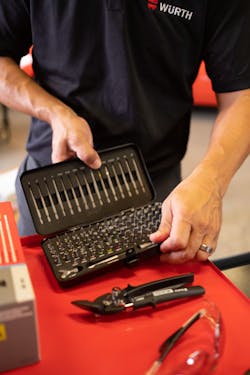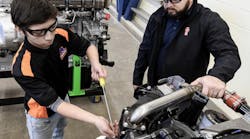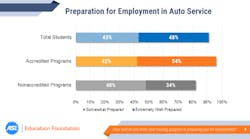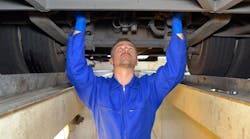It goes without saying that fleets need good technicians and good technicians need good tools. The question is: What is the most effective way for a fleet to go about ensuring that it has both?
A longstanding tradition is that technicians are typically responsible for their basic tools, like a common set of hand tools. Jason DeAngelo, Wurth USA regional sales director, says fleets often provide some kind of tool allowance to help new technicians get started in their careers. From that point on, however, technicians often bear the financial responsibility of adding to their toolboxes.
Tool suppliers are continually bringing new, innovative tools to the market. Many are potential solutions to some of the biggest challenges technicians are facing. Whether the fleet or individual technician end up taking on the cost of procuring those new tools, prioritization is key.
“Maintenance is maintenance and will always be a variable,” DeAngelo says.
In other words, a fleet must think about the problems it is facing in its pursuit of maximum uptime, and then seek out solutions to those problems. They must also prioritize their tool investments based on their biggest needs. Wurth USA is a supplier of vehicle services, parts, and products, including an expanding line of hand tools.
Identifying new tooling opportunities
According to Wurth USA’s DeAngelo, a fleet can lean on its veteran technicians for advice on new tooling opportunities. As different jobs come through the shop, technicians are likely to run into various challenges where unique tools could be of assistance.
“Technicians have a handle on the day-to-day, as well as solutions they may have heard about that could make their jobs faster and more profitable,” DeAngelo says. “I don’t think a fleet manager would be in a very good position without the willingness to listen to his or her [technicians].”
As vital as communication with technicians can be, finding the time can be a challenge. After all, time spent chatting is time away from turning wrenches. DeAngelo says he has seen a few different ways fleets are going about this.
“Some fleets have an internal electronic message board where technicians can share ideas and best practices with each other, including insights on useful tools,” DeAngelo relates.
If a software-driven, internal message board isn’t an option, some organizations have found closed Facebook or LinkedIn groups to be an effective way to foster communication and collaboration among employees.
“A fleet should simply determine the most effective way to maintain communication,” DeAngelo says. “We’ve seen some fleets devote part of their weekly morning meetings for discussion about new tools. Exit meetings at the end of shifts represent another possibility.”
Regardless of how a fleet goes about conquering its communication challenges, it will likely be time well spent.
“If I’m a technician and want to figure out a problem, I want to share what I’ve learned with others to help them, even if they are four states away,” DeAngelo says.
In many instances, that includes sharing insights on a new method or tool to address a maintenance or repair challenge.
Fleet-owned versus technician-owned tools
Some fleets are seeing advantages in providing fleet-owned tools to technicians rather than expecting technicians to purchase all of their own tools. Doing so can help fleets get new technicians up and running faster, as well as technicians coming from other industries such as heavy equipment, agriculture, or even the military.
“We don’t have any kind of tool reimbursement programs because we just go ahead and supply all tools for our technicians,” says Kevin Schlangen, fleet manager for Dakota County Fleet Management, a public sector fleet based in Rosemount, Minnesota.
When determining which tools a fleet should pay for and take ownership of, Matt Copot, vice president of maintenance for Transervice, says it largely depends on the types of repairs being performed. Transervice is a provider of freight management, fleet leasing, and contract maintenance services.
According to Copot, larger air tools, computers, diagnostic software and tools, tire changing equipment, transmission jacks, wheel dollies, air compressors, grinders, drill presses, saws, jacks and jack stands, A/C machines, welders, vises, battery jump starters, and hose reels would all be included in the typical fleet’s owned inventory. Individual technicians would be responsible for their own wrenches, screwdrivers, sockets, extensions, smaller air tools, creepers, and toolboxes for their day-to-day repairs.
Some fleets are also seeing the benefit in providing financial assistance to technicians required to buy their own tools, for many of the same reasons listed above. This could become a costly expense for fleets if they are not careful. However, a pragmatic, budget-based approach can make it entirely feasible, whether you’re talking about some kind of monthly allowance added to a paycheck, an end-of-year reimbursement, etc. Regardless, incentives that help technicians purchase new tools can be viewed as investments by the fleet — investments that may generate a healthy return by way of increased shop productivity and decreased vehicle downtime.
Additionally, sharing the cost burden with technicians creates a unique selling proposition when recruiting technicians to work for your fleet. With the technician shortage there is today, qualified technicians can essentially pick and choose where they want to work. A fleet that helps defray the cost of obtaining the latest tools and innovations could prove to be the benefit that helps draw new recruits to the organization.
“We offer a stipend for tools, along with tuition reimbursement,” says Copot, adding that “technician support” is a concept that should extend beyond just tools and equipment. “The technician’s most important tool is their mind and staying current with training is vital to their success. In doing so, we provide our technicians with a bonus for each ASE certification they receive to encourage them to continually improve themselves.”
Another benefit of fleet-owned tools is availability. When technicians own the majority of their tools, they completely control the availability of those tools.
Another concept to think about is standardization. When a fleet owns the tools, it can identify those that are most essential to productivity, and ensure those tools are in every technician’s toolbox. Likewise, when tool suppliers bring new innovations to the market, the fleet can identify those that would provide the most value to their shop, and make sure that everyone who needs one has one.
The role of tool suppliers
Checking out tool trucks is a common activity for technicians, including those working within commercial fleets. One train of thought is that every minute a technician spends on a tool truck looking at inventory is time spent away from the bay. A fleet may find that it is advantageous for one person to handle interactions with tool trucks.
But that doesn’t mean input from the technicians isn’t important. In fact, it is crucial.
“Managers should engage in conversations with technicians to understand what types of issues they might be having when fixing equipment,” Transervice’s Copot says. “Ask the technicians what they are having trouble with and if they determined that special tooling was necessary for repairs.”
Fleets should also periodically look through their tool room to see if tools are worn out and need to be replaced, Copot adds. Furthermore, fleets should make it a practice to ask technicians if they are having trouble with any of the existing tooling.
If a fleet is looking to regain more ownership of the tools in its shop, thoughtful return on investment (ROI) analysis is going to be necessary.
“Depending on the scale of the purchase, ROI should be based on the initial purchase price versus anticipated productivity gains,” Copot says. For example, a shop tool would account for cost and yield of reduced labor hours. Then the saved labor hours leads to more available hours to dedicate to repairs.
“Don’t get caught in a trap of expecting ROI to be recouped too quickly,” Copot cautions. “Be realistic with the expectations and your presented timeline.”
Tool suppliers can play a productive role in this process.
“It is the tool supplier’s job to come into a fleet, listen to their needs, and come up with innovative solutions to help technicians do their jobs better, faster, and safer,” says DeAngelo of Wurth USA.
While Wurth USA doesn’t follow the common industry sales model of direct-to-shop mobile tool truck distribution, it does place significant emphasis on the concept of regular shop visits.
“Our sales personnel like to keep the same schedule when visiting customers, whether that is once a week or maybe every other week,” DeAngelo says.
Regardless of the frequency, it is the fleet that dictates its needs to Wurth USA. Wurth USA sales staff, whom DeAngelo says are trained to function more like consultants, then keep to the predefined schedule.
“We want our fleet customers to know that on whatever day and at whatever time, their Wurth representative will be there to check in,” DeAngelo says. “If a technician is having issues with something, our sales consultant will be there to hear about it and offer ideas and solutions based on what he or she has seen other fleets doing to address a similar issue.”
In many instances, it is a new tool that will help address the issue. While Wurth USA doesn’t dispatch trucks full of product to its fleet customers, it does equip its sales consultants with catalogs and product samples to help show the latest to technicians.
“Technicians often view tools like a child views toys,” DeAngelo relates. “Anything new is always exciting. Sometimes it’s about taking an old idea and just making it better through innovation.”
That is precisely why fleets need to think about how they are going about assessing the tool and equipment needs of their shops, and what they are doing to help their technicians get the tools they need to be as safe, productive, motivated, and loyal as possible.








